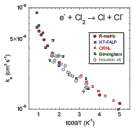Department of Physics and Astronomy: Publications and Other Research

Ilya Fabrikant Publications
Document Type
Article
Date of this Version
2016
Citation
PHYSICAL REVIEW A 94, 012701 (2016)
Abstract
Using the convergent close-coupling theory we study the threshold behavior of cross sections for positronium (Ps) of energy E scattering on antiprotons. In the case of Ps(1s) elastic scattering, simple power laws are observed for all partial waves studied. The partial-wave summed cross section is nearly constant, and dominates the antihydrogen formation cross section at all considered energies, even though the latter is exothermic and behaves as 1/E1/2. For Ps(2s), oscillations spanning orders of magnitude on top of the 1/E behavior are found in the elastic and quasielastic cross sections. The antihydrogen formation is influenced by dipole-supported resonances below the threshold of inelastic processes. Resonance energies form a geometric progression relative to the threshold. The exothermic antihydrogen formation cross sections behave as 1/E at low energies, but are oscillation free. We demonstrate that all these rich features are reproduced by the threshold theory developed by Gailitis


Comments
©2016 American Physical Society